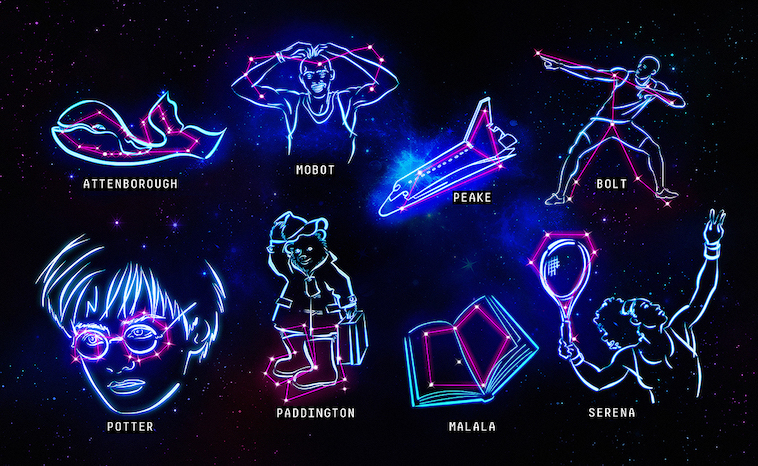New Constellations Created For Young Observers

Have you ever looked into the nighttime sky to see constellations of fish, bears, or ancient Greek heroes? Astronomy experts have recently added some new exciting constellations. Read on to find out who and what now fills the night sky.
Where did our modern constellations come from? Who created them? Our current constellation system comes to us from the ancient Greeks. A poem called Phaenomena, written by the Greek Poet Aratus in 270 BC, includes a reference to constellations. We know that the man had already named some of the star groupings in the sky.
Early Depictions
Based on the location of the Aratus’ constellations we know that the people looking at them lived near a latitude of 36° north-south of Greece, north of Egypt, but similar to the latitude of the ancient Babylonians and Sumerians. Consequently, it appears that the Greek constellations began with the Sumerians and Babylonians. How did the Egyptians find out about constellations?
Three and a half thousand years ago, the tiny Aegean island of Thera fell due to a massive volcanic eruption. This devastating explosion forced the Minoans from the island where they later settled in Egypt. The Minoans had trading contact with the Babylonians. As a result, researchers believe that the Egyptians learned of the constellations from this influx of people.
Ptolemy’s Constellations
In 150 A.D., the Greek scientist Ptolemy published a book, known by its Arabic name, The Almagest, which contained a summary of Greek astronomical knowledge. It also included a catalog of 1022 stars. Ptolemy estimated the star’s brightness and arranged them into 48 constellations. These 48 formed the basis for our modern constellation system.
Later astronomers added constellations to fill in the sky. Ptolemy had left gaps and also left out the regions near the south celestial pole. Major contributors of new constellations included Dutch cartographer Gerardus Mercator in 1551 and Pieter Keyser and Frederick de Hautmann. Merchants traveling aboard ships bound for trading in the East Indies also mapped the night sky. During the 1600s they mapped the southern sky. Polish astronomer Johannes Hevelius in 1690, and French astronomer Nicolas Louis de Lacaille in the 1750s, filled in the remaining gaps in the northern and southern skies.
New Constellations
What new constellations did The University of Birmingham create?
The Big Bang Fair partners with astronomers at Birmingham University to create a series of new constellations in honour of famous men and women that are inspirational to young people today.
The icons that have been commemorated include Usain Bolt doing his celebratory lightning-bolt stance, Sir David Attenborough in the shape of a blue whale, JK Rowling through Harry Potter's iconic glasses, Mo Farah doing his Mobot celebration, a spaceship for Tim Peake, a book for Malala Yousafzi and author Michael Bond through Paddington Bear's boots.
The constellations have been created with a view to getting more young people interested in stargazing and the universe. They arrive in the wake of research from The Big Bang Fair which found that 72% of children have never looked up at the night sky to find a star constellation before, while 29% wouldn’t be able to recognise a single classical constellation when shown them.
For more information email [email protected] or call 0207 234 9150.
- Malala Yousafzai – Book- Look North (NNW) – February (Winter)- Pakistani blogger who survived being shot by the Taliban.Youngest Winner of the Nobel Peace Prize
- Harry Potter’s Glasses- Look North (NE)- March (Spring) The young wizard from J.K. Rowling’s book, Harry Potter.
- Sir David Attenborough Whale- North (NNE)- April (Spring) English Naturalist famous for his documentaries about plant and animal life on Earth.
- Tim Peake Spacecraft- East (ESE)- April (Spring) English astronaut and the first British European Space Agency astronaut. Former ISS crew member.
- Sir Mo Farah- Mobot- East (ENE0- June (Summer) British long-distance runner.
- Serena Williams Tennis Racket- North (NW)- September (Summer), American tennis player.
- Usain Bolt Lightning Bolt Celebration- East (E)-November (Autumn) Jamaican sprinter known for holding both the 100 meters and 200-meter world record.
- Paddington Bear – East (E)-December (Winter) Famous fictional bear created in 1958 by Michael Bond.
The addition of famous names and characters may encourage a younger generation of observers to look toward the night sky. Although they may be unable to recognize Greek heroes and Gods from current constellations, these new constellations are modern and fun. Researchers hope these new creations will help people of all ages develop their interest in space and astronomy, working to inspire the next generation of astronomers to take an interest in the field.
